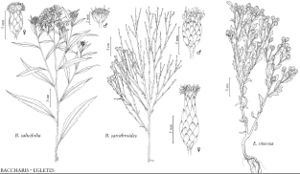Egletes
Bull. Sci. Soc. Philom. Paris 1817: 153. 1817.
| Taxon | Illustrator ⠉ | |
|---|---|---|
 | Baccharis salicifolia Baccharis sarothroides Egletes viscosa | Yevonn Wilson-Ramsey Yevonn Wilson-Ramsey Barbara Alongi |
Annuals, 10–60 cm (gland-dotted; taprooted). Stems erect to decumbent, much branched, sometimes arachnose in early growth. Leaves basal and cauline; alternate; petiolate or sessile; blades (1-nerved) obovate to spatulate (bases clasping to subclasping), margins pinnatifid [lobed or toothed], (apices rounded to obtuse or acute) faces glabrous, villous, or tomentose, sometimes stipitate-glandular. Heads radiate, usually borne singly (axillary, apparently opposite leaves), or in loose corymbiform arrays. Involucres shallowly hemispheric or cupulate, ([3–] 4–6 × 4–10 mm). Phyllaries 10–25 in 2–3 series, lanceolate-triangular, subequal, thinly herbaceous, flat, margins scarious or not, abaxial faces glabrous or stipitate-glandular, villous, or tomentose. Receptacles conic, pitted, epaleate. Ray-florets 18–28 [16–200] (in 1 [–4] series, 1-nerved, midnerves barely evident), pistillate, fertile; corollas white to bluish white (laminae broad or filiform, longer or shorter than involucres). Disc-florets 130–300 bisexual, fertile; corollas yellow, tubular-funnelform (with slight differentiation of tubes and limbs), tubes shorter than throats, lobes 3–5, erect, deltate; style-branch appendages triangular. Cypselae oblong to narrowly obovoid, slightly compressed, 2-ribbed, glabrous or stipitate-glandular; pappi whitish, coroniform (cartilaginous crowns or shallow cups [broad, flaring]). x = 9.
Distribution
Tex., Mexico, West Indies, Central America, South America
Discussion
Species 6 (1 in the flora).
The species of Egletes occur mostly in coastal habitats, from south Texas and Mexico through Central America, northern South America, and the Lesser Antilles. Plants are characterized by their low, herbaceous habit; glandular-resinous vestiture; narrow, multiseriate, often inconspicuous rays; conic receptacles; and compressed, glandular cypselae with coroniform pappi.
Selected References
None.